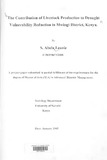| dc.description.abstract | Mwingi district records a 66% probability of food crop failure and consequently food shortage as a result of recurrent droughts. This situation compels farmers to engage in various coping mechanisms including livestock production and the use of livestock products.
Using interview schedules for both farmers and key informants, a study was conducted with the aim of finding out to what extent livestock production contributed to drought vulnerability reduction among farmers in Mwingi district. The study also sought to highlight the major constraints that handicap the livestock production. It also explored the existing and potential economic opportunities that lay untapped in the above-mentioned sector.
The data collected from both farmers and key informants, were analyzed both quantitatively and qualitatively. Thus, the study unveiled that farmers were involved in multiple farm and off-farm enterprises in order to diversify their income and ultimately, enhance their capacity to alleviate drought effects. Respondents' monthly income ranged between Ksh 1,000 and 20,000 with the
majority (72.4%) situated within the range of Ksh 1,000 and 5,000. As the monthly income grew higher, the male respondents controlled it.
The majority of respondents stressed the important role played by livestock sector in reducing drought vulnerability. It was established that the majority of farmers rely on their livestock to
survive the effects of drought as compared to other livelihood activities. Selling livestock and livestock products constituted their primary source of income in that it not only provided them
with money to buy food in times of crisis, but it also constituted a living bank for all other households needs such as payment of school fees/hospital bills/dowry and other social and financial needs.
Unfortunately, livestock sector is not given priority in terms of development by both institutions and farmers. The findings established that although farmers do enjoy the benefits secured from livestock keeping, their priority remained the improvement of crop fanning than livestock production in terms of development. Therefore, its full potential remained untapped given the fact that most effort was concentrated on crop farming.
The study also identified some major constraints on livestock development, diseases and pests, scarcity of water, poor market systems, limited skills in animal husbandry and inadequate veterinary services.
Finally, the study explored a few ways in which livestock pro financial and social capital. Livestock ownership was considered as upon when needs arise. It was found that livestock were used to cen borrowing, sharing and lending of animals. They were offered as sacrifice during religious cults.
To make livestock production more profitable to farmers, theaccessibility and availability of veterinary services. Also improving and accessibility of water would impact positively on the development given adequate support, livestock development in the area of building sustainable livelihoods in Mwingi. | en_US |

